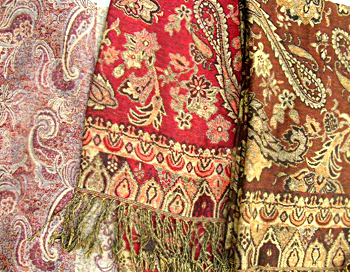 Pashmina wool has enthralled the Indian population as well as the whole world through its softness and warmth. History of Pashmina wool narrates that this material continued to serve the people since ancient times. Pashmina is believed to have originated around 3000 years B.C. It is a kind of art of weaving that was passed on from one generation to another to carry on the legacy. Thus the artistry of the ancient people was imbibed to the present Indian society. The word pashmina has a Persian origin and the term stands for wool.
Pashmina wool has enthralled the Indian population as well as the whole world through its softness and warmth. History of Pashmina wool narrates that this material continued to serve the people since ancient times. Pashmina is believed to have originated around 3000 years B.C. It is a kind of art of weaving that was passed on from one generation to another to carry on the legacy. Thus the artistry of the ancient people was imbibed to the present Indian society. The word pashmina has a Persian origin and the term stands for wool.
According to the History of Pashmina wool, the origination of the wool can be traced to Nepal many years back. The people of Nepal started weaving the fabrics for their warmth and especially for survival. Thus the threads of Pashmina began to comfort the people living in the temperate regions of India. According to historical records, soft, intricately made cloth was used for the kings, emperors, and the aristocracy in ancient India.
The History of Pashmina wool unveils that the wool was first manufactured perfectly by the Nepalese and they faultlessly undertook the skill of retrieving pashmina. In fact, Kashmir was the only place in India for over a period where the fibre could be woven into shawls. In addition to that Pashmina was supplied from Tibet to India. During the medieval period of India, production of Pashmina also reached a height from the benefaction of the Mughal rulers like Akbar and his successors, and also because of the patronage of the local government. It was produced and traded for the benefits of the Indian craftsmen. However with the collapse of the Mughal Empire, the Europeans tried the overture of making pashmina a demand in the European society. Thus, Pashmina started to capture the aristocracy since the 15th century till recent times. The Europeans introduced trading pashmina to the western world where it became popular as cashmere wool from the word `Kashmir`.
In the modern times Pashmina wool has gained popularity all over the world. The material is exported as a finished product as the western market has created a great demand for this exquisite fabric. The textile became popular in the West in the late 1990s. At present Pashmina is available in quite a reasonable price, the garments made from it is presented with wonderful motifs and designs. Most of the dresses from Pashmina wool are woven on spun silk, giving it more suppleness and durability. Over the years thus pashmina fabric has evolved into other, equally beautiful forms, such as the pashmina stoles, scarves, sweaters, mufflers and a host of other pashmina products.





















